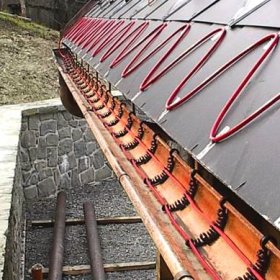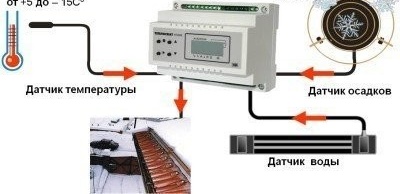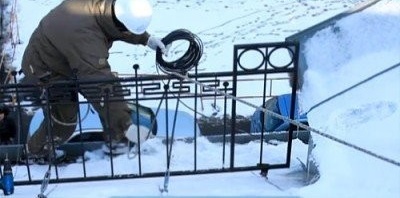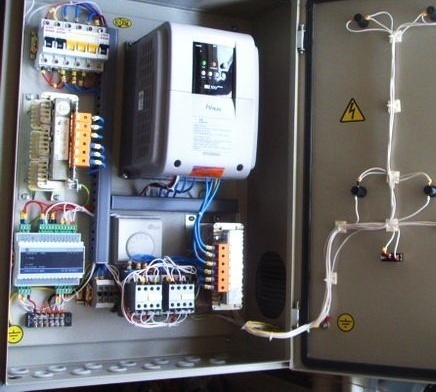Roof heating: what is a cable anti-icing system and how to install it

Massive icicles and heavy layers of snow on the roofs of houses in the winter are not only aesthetically pleasing, but also very unsafe. They pose a serious threat to the health and life of people, the integrity of vehicles. In addition, such "formations" are fraught with premature destruction of the roofing, damage to the facade, the occurrence of cracks in the ceilings. Therefore, the issue of effective removal of ice on the roof is incredibly important and serious.
To date, the most optimal way to solve this problem is to install a cable anti-icing system. The system is completely invisible and works in automatic mode; thanks to humidity and temperature sensors, it turns on and off, spending exactly as much energy as necessary.
The first and main reason for the formation of ice on the roof is a poorly insulated roofing cake. It allows high heat loss, so a positive temperature can be established on the surface of the roof itself, even despite negative outdoor temperatures. As a result, the snow melts, the resulting water drains into the drain. But it is devoid of "spurious" heating, so there the liquid freezes, forming an ice roller. And then the water simply overflows through this roller and freezes already at the edge of the roof, forming the notorious icicles.
The second reason for icing the roof is the natural daily and seasonal temperature differences. Sophisticated roof construction can also cause ice formation.

De-icing systems are an effective tool for protecting facades, gutters and gutters from destruction. And they help to maintain the aesthetic appearance of the building throughout the entire period of operation
Content
Why is a snow melting system the best choice?
The fight against ice on the roof is carried out in various ways. However, only cable electrical heating of the roof is considered a truly effective and safe method. If the equipment is installed correctly, in compliance with all technological nuances, the problem with icicles can be forgotten.
Mechanical and chemical methods lose to the cable de-icing system in many ways. The first, although it is the most common and least expensive, requires the use of special equipment and the invitation of specialists trained in working at height, which is not always convenient, and in the "long term" this option is not so cheap. In addition, crowbars and shovels can seriously damage the roofing material and the drainage system. The second consists in applying special emulsions to the corresponding surfaces, which are not only expensive, but also need to be periodically updated (usually several times a season).
Therefore, the conclusion is obvious, the roof anti-icing system is the simplest and most reliable solution to the problem of ice on the roof, which does not require regular labor costs. And, as practice shows, its installation pays off in full.

If the anti-icing system is calculated correctly, and the components are of high quality, then its operation will be effective regardless of weather conditions
Cable heating is able to cover all problem areas of the roof:
- drainpipes;
- gutters;
- funnels;
- endow;
- trays for collecting water;
- droppers;
- snow retention.
Moreover, complete heating of the roof is not necessary at all. As a rule, laying heating elements in the most problematic places, where ice and snow accumulations are maximum, eliminates the problem of freezing the entire roof area.
It is also worth noting the following advantages of anti-icing systems: low operating costs, preventing the accumulation of rain and melt water, as well as compatibility with flat roofs.
The main elements of the anti-ice systems
A key element of snow melting systems is, of course, cable. Its power can be either linear (constant) or self-regulating (changing depending on weather conditions).
The use of a resistive cable with constant power has certain disadvantages. Since different sections of the roof have different heat requirements, it can happen that the cable will overheat in certain places, and for a number of zones it simply does not have enough power. If, due to limited funds, you are staying on a resistive cable, you should pay due attention to accurately calculating its length to ensure the required power.
It is worth remembering that the resistive cable requires constant "care": it is covered with debris or leaves, due to overheating, it can burn out.
Self-regulating cable is a more expensive option, but also more practical. He knows how to adapt to each specific section of the roof, is very convenient to install, and reduces energy consumption. Since the self-regulating cable is not prone to overheating, it does not need additional maintenance either - and this is a significant plus.

The choice of power for a roof heating system depends primarily on the quality of the roof insulation. The maximum power requires the so-called. “Hot roof”, the attic under which is used either as a living room, or for wiring the heating system
The roof anti-icing system also includes: sensors, thermostats, ballasts, a cabinet for equipment and a signal cable.
The principle of cable heating
The main task of snow melting electrical systems is to free up the path for meltwater runoff and escort it to the lower segment of drainpipes at any temperature. Cable heating should work until snow melting on the roof is completely stopped. And the speed of this process depends on various factors:
- construction of the roof;
- air temperature;
- the quality of the roofing cake, the amount of "parasitic" heat released;
- wind power;
- humidity, etc.
Therefore, the algorithm for the functioning of the heating control system is quite understandable: with the help of humidity and temperature sensors, it monitors all possible changes and turns on the heating only at the right time, saving energy. Not to waste energy is very important, since the total power of the cable heating of the roof can be quite large.
As soon as the outside temperature falls within the operating range of the system, it is switched on for a time period set by the timer. After the allotted time, the machine turns off, and water and precipitation sensors come into operation. If there are too many of them, the heating of the roof, gutters and trays is switched on. After the cessation of precipitation, the roof itself ceases to be heated, but the heating of pipes and trays still continues to function for some time so that the gradually draining melt water cannot freeze in the drainage system.All on and off occur in automatic mode - no extra hassle.
Installation of snow melting and anti-icing systems
It is extremely problematic to install the anti-icing system with your own hands, because for the correct connection and adjustment of automation, special knowledge and skills are required. In addition, the installation of a gutter heating system often requires industrial mountain climbing services. Therefore, it is advisable, nevertheless, to entrust this work to competent professionals.
In general, the roof heating cable system is mounted in three stages. On the first, a heating cable is laid and fastened. The second is the installation of automation and sensors. Automation directs the current through the cable at the right time, and the sensors transmit information about the "weather" on the roof. At the third stage, commissioning is carried out. The resistance in all cables of the system must be measured, grounding is established, the operation of the emergency shutdown is checked. Only after careful monitoring of all parameters and checking the health of the equipment can the cable heating system of the roof be allowed to operate.

The installation of a cable roof heating system is fraught with a certain danger: without experience in high-altitude work, it is better not to undertake its independent

You can make an approximate calculation of the cable de-icing system for your home using special online calculators. By setting the necessary system parameters in the appropriate fields, you can find out its approximate cost.
Some nuances to consider:
- The perforated mounting tape or clamps will help secure the cable. When using clamps, it is very important to tighten them carefully.
- To determine the cable laying step, appropriate calculations must be made.
- At the bottom of the drainpipes, it is recommended to lay more turns of cable.
- If the drainpipes go straight into the storm sewer, they must be heated right up to the freezing point of the earth in this region.
- Downspouts passing inside the building need heating only in the upper part.
Systems for melting ice and snow can serve faithfully for years. New investments are extremely rare. An annual examination before the start of the winter season is the only condition for their successful operation.


